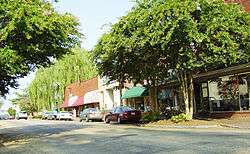Smithfield, Virginia
| Smithfield, Virginia | ||
|---|---|---|
| Town | ||
|
Main Street, Smithfield | ||
| ||
| Nickname(s): The Ham Capital of the World | ||
|
Location in the Commonwealth of Virginia | ||
| Coordinates: 36°58′44″N 76°37′7″W / 36.97889°N 76.61861°WCoordinates: 36°58′44″N 76°37′7″W / 36.97889°N 76.61861°W | ||
| Country | United States | |
| State | Virginia | |
| County | Isle of Wight | |
| Incorporated (town) | 1752 | |
| Government | ||
| • Mayor | David M. Hare (term expires 6/30/2012) | |
| Area | ||
| • Total | 10.1 sq mi (27.1 km2) | |
| • Land | 9.5 sq mi (24.7 km2) | |
| • Water | 0.9 sq mi (2.4 km2) | |
| Elevation | 30 ft (9 m) | |
| Population (2010) | ||
| • Total | 8,089 | |
| • Density | 851.5/sq mi (330.16/km2) | |
| Time zone | EST (UTC-5) | |
| • Summer (DST) | EDT (UTC-4) | |
| ZIP codes | 23430-23431 | |
| Area code(s) | 757 | |
| FIPS code | 51-73200[1] | |
| GNIS feature ID | 1474779[2] | |
| Website | www.smithfieldva.gov | |
Smithfield is a town in Isle of Wight County, in the South Hampton Roads subregion of the Hampton Roads region of Virginia in the United States. The population was 8,089 at the 2010 census.
The town is most famous for the curing and production of the Smithfield ham. The Virginia General Assembly passed a statute defining "Smithfield ham" by law in 1926, with one of the requirements that it be processed within the town limits. Currently, Smithfield Foods, a Fortune 500 Company that owns Smithfield Packing Company and others, is the world’s largest pork processor and hog producer. The company, based in Smithfield, raises 12 million and processes 20 million hogs annually.
History and industry
Smithfield, first colonized in 1634, is located on the Pagan River, not far from Jamestown. The Native Americans knew this area as Warascoyak, also spelled Warrosquoyacke, meaning “point of land.”
Warrosquyoake Shire (with numerous variant spellings, including Warrascoyack, Warrascocke and "Warwick Squeak") was officially formed in 1634 in the Virginia colony, but had already been known as "Warascoyack County" before this. It was renamed Isle of Wight County in 1637.
In 1730, the Tobacco Inspection Act of 1730 established "Warricksqueak Bay, in Isle of Wight County" as the site of an official tobacco inspection house.
The town was established in 1752 by Arthur Smith IV as a seaport. The original survey and plat of the Town of Smithfield was made by Jordan Thomas, County Surveyor, for Captain Arthur Smith in 1750.[3]
As a river town, its life and growth were dependent on the river. “Wharf Hill” was the waterfront location of the beginning of the industries of Smithfield, which would evolve into “The Peanut Capital of the World” and “The Ham Capital of the World." George Purdie, Gent., a County Justice and Postmaster of Smithfield during his lifetime, purchased Lots 4 & 5 of the original plat of the Town of Smithfield in 1763. Purdie's neighbor, Captain Mallory Todd, built the business of curing and shipping the hams that has made Smithfield world famous. {George Purdie Merchant of Smithfield by Doris Gwaltney, a descendent by marriage}. The peanut industry continued until the fire of 1921, which destroyed the peanut warehouses and therefore the growing peanut businesses; the peanut trade then moved to the nearby railroad hub of Suffolk, Virginia.
There were both Revolutionary and Civil War actions in and around the town, mostly due to its proximity to the James River. Wharf Hill was used as a safe harbor for receiving arms and supplies for revolutionary patriots and a vantage point from which Federal cannon fire showered Main Street. Its dock has welcomed the fictional drama of the real “Show Boat” (James Adams Floating Theatre).
The Mansion on Main was the showplace home of a Victorian era "Virginian of Virginians", R. S. Thomas (1837–1915)—restored by Sala Clark in the late 1990s—whose 1889 "urban" Queen Ann style mansion changed the face of Smithfield (colonial and cottage), and whose efforts helped to save a nearby National Landmark, the 1632 St. Luke's Church. Thomas literally "wrote the book" on St. Luke's Church, “The Old Brick Church Near Smithfield, Virginia,” specifically to champion its 1632 date and legacy. He presented it before the Virginia Historical Society on December 22, 1891. “It is my object to prove that this Church was built in 1632, and I shall prove it, 1. By the existence at that early date, of such strong, religious sentiment, as demanded a house of worship to the living God; 2. By tradition; 3. By lately existing records; and – 4. By the bricks and mortar of the Church itself.”
Today, Smithfield is a small town community striving to preserve its southern charm. Currently Smithfield has a population of 8,100 and is approximately 10.1 square miles (26 km2) in size.[4] The ham production operation was purchased by a Chinese firm in 2014.
Geography
Smithfield is located at 36°58′44″N 76°37′7″W / 36.97889°N 76.61861°W (36.978767, -76.618578).[5]
According to the United States Census Bureau, the town has a total area of 10.4 square miles (27.1 km²), of which 9.5 square miles (24.7 km²) is land and 0.9 square miles (2.4 km²) (8.80%) is water.
Demographics
| Historical population | |||
|---|---|---|---|
| Census | Pop. | %± | |
| 1850 | 733 | — | |
| 1860 | 777 | 6.0% | |
| 1870 | 652 | −16.1% | |
| 1880 | 814 | 24.8% | |
| 1890 | 891 | 9.5% | |
| 1900 | 1,225 | 37.5% | |
| 1910 | 1,278 | 4.3% | |
| 1920 | 1,181 | −7.6% | |
| 1930 | 1,179 | −0.2% | |
| 1940 | 1,178 | −0.1% | |
| 1950 | 1,180 | 0.2% | |
| 1960 | 917 | −22.3% | |
| 1970 | 2,713 | 195.9% | |
| 1980 | 3,718 | 37.0% | |
| 1990 | 4,686 | 26.0% | |
| 2000 | 6,324 | 35.0% | |
| 2010 | 8,089 | 27.9% | |
| Est. 2014 | 8,287 | [6] | 2.4% |

As of the census[1] of 2010, there were 8,089 people, 2,438 households (2000 census), and 1,830 families residing in the town. The population density is 851.5 people per square mile (330.2/km²). In 2000 there were 2,552 housing units at an average density of 267.9 per square mile (103.4/km²). The racial makeup of the town was 67.22% White, 30.87% African American, 0.35% Native American, 0.41% Asian, 0.02% Pacific Islander, 0.22% from other races, and 0.92% from two or more races. Hispanic or Latino of any race were 0.93% of the population.
There were 2,438 households out of which 37.1% had children under the age of 18 living with them, 53.2% were married couples living together, 17.8% had a female householder with no husband present, and 24.9% were non-families. 21.5% of all households were made up of individuals and 9.7% had someone living alone who was 65 years of age or older. The average household size was 2.55 and the average family size was 2.95.
In the town the population was spread out with 27.0% under the age of 18, 7.0% from 18 to 24, 29.3% from 25 to 44, 23.1% from 45 to 64, and 13.6% who were 65 years of age or older. The median age was 38 years. For every 100 females there were 89.3 males. For every 100 females age 18 and over, there were 82.4 males.
The median income for a household in the town was $43,224, and the median income for a family was $53,906. Males had a median income of $40,845 versus $24,419 for females. The per capita income for the town was $19,301. About 11.8% of families and 12.0% of the population were below the poverty line, including 12.7% of those under the age of 18 and 15.6% of those 65 and older.
Culture and architecture
Known as the ham capital of the world, Smithfield currently attracts many tourists. Smithfield's Historic District is a major attraction. Historic buildings that lure tourists include the Isle of Wight County Museum, Historic Fort Huger, the Schoolhouse Museum, the Old Courthouse of 1750, and Historic St. Luke's Church located just outside downtown. Countryside attractions just outside Smithfield include Boykins Tavern Museum, the Isle of Wight Courthouse of 1800, and Darden's Country Store & Smokehouse. The Jamestown/Scotland Ferry (located in Surry) also allows tourists to visit Williamsburg, Virginia as well, linking Smithfield to the historic triangle. Smithfield is also a convenient day trip from Norfolk, Richmond, and Virginia Beach.[8] Smithfield's Historic District includes over 70 buildings of exceptional architectural importance, including residences of the Colonial, Federal, and Victorian periods. Sites of historic interest in Smithfield include the 1750 Court House, the adjacent colonial tavern that is now the Smithfield Inn, the Isle of Wight Museum, the Schoolhouse Museum, the Wentworth-Grinnan House, and Windsor Castle Park.
In addition to Fort Huger, the 1750 Court House, St. Luke's Church, and the Smithfield Inn, the Fort Boykin Archaeological Site (44IW20), Four Square, P. D. Gwaltney, Jr., House, Ivy Hill Cemetery, Col. Josiah Parker Family Cemetery, Poplar Hill, Robert Tynes House, and Wolftrap Farm are listed on the National Register of Historic Places.[9]
Smithfield also offers an array of entertainment and events throughout the year. Family events include the Christmas Parade, the Smithfield Farmers Market, and Smithfield Olden Days. Local businesses and restaurants also offer entertainment. Jalapeños and Smithfield Station offer live music, while the Smithfield Little Theater offers various selections of plays throughout the year.[10]
Windsor Castle Park, Nike Park, Cypress Creek Golf Course, and Smithfield Station Restaurant, Waterfront Inn & Marina are just some of the recreational sites of Smithfield. Boating, fishing, hunting, and biking are enjoyed by many citizens of Smithfield. Smithfield also has a local skate park, trails, and campgrounds.[11]
Gallery
-
The colonial courthouse on Main Street.
-
The colonial tavern on Main Street, now operated as the Smithfield Inn.
-
The Isle of Wight Museum on Main Street.
-
The Schoolhouse Museum on Main Street.
-
The Jordan House, a private residence on Main Street.
-
The Mansion on Main Street.
-
The Gwaltney House, a private residence on South Church Street.
-
Smithfield Station hotel, restaurant, and marina.
-
Smithfield Station viewed from the Pagan River.
-

The manor house at Windsor Castle Park.
Schools
- Westside Elementary School
- Hardy Elementary School
- Smithfield Middle School (Smithfield, Virginia)
- Smithfield High School
References
- 1 2 "American FactFinder". United States Census Bureau. Retrieved 2008-01-31.
- ↑ "US Board on Geographic Names". United States Geological Survey. 2007-10-25. Retrieved 2008-01-31.
- ↑ Isle of Wight County Clerk's Office
- ↑ http://www.smithfieldva.gov/
- ↑ "US Gazetteer files: 2010, 2000, and 1990". United States Census Bureau. 2011-02-12. Retrieved 2011-04-23.
- ↑ "Annual Estimates of the Resident Population for Incorporated Places: April 1, 2010 to July 1, 2014". Retrieved June 4, 2015.
- ↑ "Census of Population and Housing". Census.gov. Retrieved June 4, 2015.
- ↑ http://www.smithfield-virginia.com/attractions.html
- ↑ Staff (2010-07-09). "National Register Information System". National Register of Historic Places. National Park Service.
- ↑ http://www.smithfield-virginia.com/events.html
- ↑ http://www.smithfield-virginia.com/recreation.html
External links
| Wikimedia Commons has media related to Category:Smithfield, Virginia. |
- Official Website of Smithfield
- Thomas House property history, house museum tours
- Smithfield Foods, official website
- Isle of Wight Museum webpage
- Isle of Wight-Smithfield-Windsor Chamber of Commerce website
- Smithfield Inn history webpage
- The Schoolhouse Museum website
- Smithfield, Virginia Historic Walking Tour website
- Smithfield Little Theatre website
| |||||||||||||||||||||


